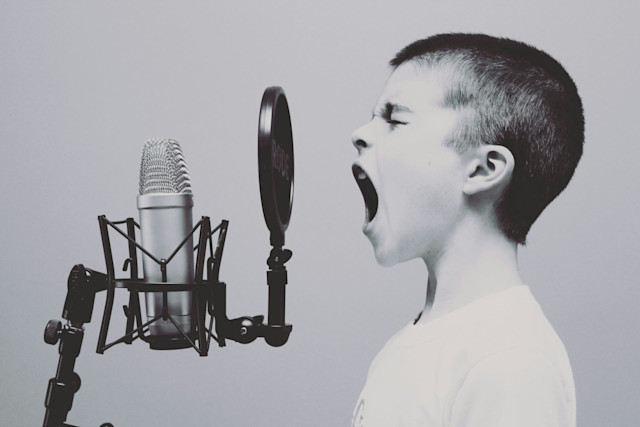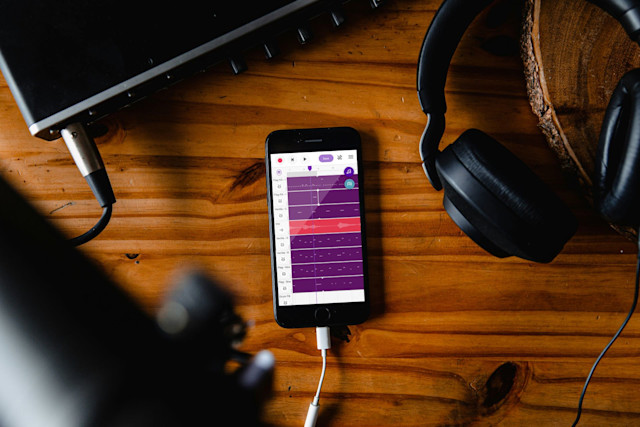How to Capture Emotions While Recording in Soundtrap
October 27, 2024 - Have you ever sat down to record something and gotten nervous? In order to capture complex and delicate emotions, one needs to be able to cultivate a specific mindset. Here’s how.

Have you ever sat down to record something and immediately gotten nervous? In order to capture complex and delicate emotions, one needs to be able to cultivate a specific kind of focused mindset.
In this article, together we will look into the unique kind of focus one needs when recording.
But first? Let’s talk about the problem at hand. Here’s a little scenario that might sound all too common:
You warm up on your instrument and tune.
Next, you open your device and cue up a DAW.
You lift your instrument into the playing position and…Boom. You seemingly forget everything you previously learned
Some days, the daunting look of the click track (every moving forward) and a microphone hovering above us can send us into a musician-glitch to the point of not even being able to play hot cross buns well. So what is one to do?
Step 1: Getting Used to Mics & the DAW
The above scenario I described feels similar to performance anxiety. To help combat that recording jitters, record more frequently. Sing or play into the same microphone you’ll use- even when it’s not on. Acclimate to the tools you use will help this issue fade.
You can even complete practice sessions, and record them while your DAW is on. The more familiar you are with your set-up, the less problem it will be. When we’re practicing, we tend to feel at ease, and that it’s ok to make mistakes. This is how we want to feel in the studio.
Shift your mindset from “Oh no, it’s showtime, ready set…go!” to “Let’s see where this takes me”. I also like to repeat this though as a sort of mantra:
If I don’t like it, I can just redo it
If I don’t like it, I can just redo it!
Listen to Soundtrap’s Click (but don’t look!)
The click and recording visual are like a train on a track…going and going, further than the eye can see. It’s best to not look at how far you have to go while you’re recording. That’d be like starting your master's degree and trying to look at all of the lessons- in a single week.
Music comes together like legos. One piece at a time, in careful notches that fit together seamlessly.
When you have Soundtrap open, hit record, and look away from the interface. I prefer to keep my laptop on my right side to the point where I can barely see it peripherally. To avoid being late to your entrance, you can even set up a blank buffer measure at the beginning of your song.
Why Acclimating to Equipment is Essential Artistically
The first paragraph of this article may make it seem like we’re going in the wrong direction. What could acclimating to your DAW possibly have to do with emotions and recording?
Everything.
If you don’t feel at ease or calm while performing for your microphone, you certainly won’t be able to tell your DAW your deepest, rawest truth. Speaking of…
Emotions: Only Record It When You’re Feeling It
Emotions come and go quickly, like the waves of a tide. If there is a specific emotion you’re trying to capture, it’s easiest to do it while you are feeling it. It’s much more difficult to try and make yourself sound melancholy, affectionate, regretful, etc.
I once wrote a piece called “Doll”. It was about (fittingly) being toyed with. The piece of paper had floated around for weeks, but one day when I was on the brink of that emotion taking me over…I finally recorded. I sent it to guitarist Samuel Rugg, and he was floored. I immediately told him that thought it was too raw. Sharing it felt like showing up to the fruit market naked. He said? “I’m recording guitar to this ASAP, it’s perfect, let’s put it online”.
You can also try to pull the move that actors do when they’re working to bring out a certain feeling. Think about or read a poem or movie that makes you deeply affected. Rather than thinking of this method as a way of forcing an emotion, imagine that you’re pulling out a thread from an old knitted shirt: It’s all already inside of you.
Applying Emotion Labeling & Narrative Forming to Music
Next time you’re writing a song, try this practice alongside it.
Name the emotion the song has
Determine the feelings' intensity
Decide it’s controllablity, conductiveness…
Finally, describe the body feeling it gives you
From there, the intensity you feel can be reflected in the way you produce the song in Soundtrap. If it’s a happy song with low intensity, you might choose a pingy gentle harp loop. If it’s a deep one, you might choose the opposite, like a minor Trap loop.
I recently read a thesis on emotion labeling: The practice of evaluating an emotional experience. The complete thesis is located here for those who want to see the full piece. Key takeaways from the study include that 1. Each emotion comes with a trigger and 2. Those emotions live somewhere in our bodies. The author Anna Wiederkehr goes on to explain in the next article how a narrative can be formed based on that experience.
This is what we aim to do in emotional music: Form a sonic narrative.
Keep Materials Ready to Go
Since feelings are so fleeting, it’s best to keep everything you need around and easy and set up. If you can’t get it ready in 5 minutes or less, it’s not prepared enough.
Even if you plan to go into a studio and rerecord later, having the fervor captured once will go a long way. Your producers can aid you in bringing that out again.

Hone In Your Vocal Delivery
Another issue that can arise is that you’re feeling the emotion, but failing to deliver it sonically. This often happens with vocals specifically. If you’re recording feels flat or lifeless, know this:
The chosen emotion needs to match the delivery
Volume must also match
Practicing with a mirror will help
By memorizing the body feeling, you’ll get back to the emotional space quicker
As our friend the Smart Rapper mentioned in the video, it’s quite comical if you’re writing a romantic song and then suddenly use a loud, bombastic voice to say “I LOVE YOU!”. Consider the entire color palette of emotions and what kind of volume would be appropriate with them.
Practicing different emotions in front of a mirror and or microphone feels very silly- at first. But it will help you deliver an emotion on the spot in the future.
Vocal emotion and versatility of timbre also require vast changes in the inside of your mouth (which is your instrument's resonating cavity!). Use a mirror and sing. Look at how your face shape and timbre change with each emotion, and remember that body feeling. You’ll need it later!
Creativity and Frustration: On Recording Rage
Few bloggers talk about it, but everyone I know who makes music has experienced it: Recording rage.
If you’ve ever gotten to the point of wanting to knock over a music stand or chuck the nearest tissue box, you know what it is. Sometimes the frustrations of doing the same thing over and over again get to you. It’s like being stuck in a physical record-scratching motion. You go back and forth and back and forth…until something or someone else has to finally stop you.
There are two main causes for this musician-affliction: Performance frustration, and tech issues. Recording rage comes up for many of us during technological issues. Luckily, this isn’t really an issue inside Soundtrap because of its quick loading, accessible and easy-to-use workflow.
On occasion, recording rage can be used to capture vocal angst or other dark feelings. But most of the time? It’s best to hit pause and grab some fresh air and a snack.
Other Methods of Cultivating Feelings in Music
Consider the following:
The way the timbres interact (instrumentation)
The way the chords are stacked (inversions)
What emotion does the chord progs convey
How FX and mixing tweak the flavor
There are a plethora of other ways to boost emotion in tracks. Instrumentation, orchestration, subject matter, choice of chord progression…and even the way the song is mixed and produced will affect the way the tune comes across.
In Soundtrap, it’s easy to make a vibe come to life. For example, you can choose a genre and music niche by using producer packs. The platform also makes it simple to pick a key and stay inside it, since all loops chosen are automatically converted into that key center. From there, use the above tips and tricks to get up in your feels.
Capturing Emotions in Recording: Conclusion
The next time you sit down to record, remember our mantra.
“If I don’t like it, I can just redo it
If I don’t like it, I can just redo it!”
From there, let your emotions be free to rise, or nudge them out. And (of course) be sure to use Soundtrap’s easy-to-navigate to fend off the dreaded recording rage.
Haven’t checked out Soundtrap yet? Visit this link to try it for free.
Get out there, and explore all the hues of feeling that music can impart.
About the author
Aleah Fitzwater is a multi-instrumentalist, songwriter, music journalist, and blogger from Temperance, United States. Aleah holds a Pk-12 instrumental music education degree. Her main instruments are flute, piano, drums, bass, and guitar.
Get started with Soundtrap today!